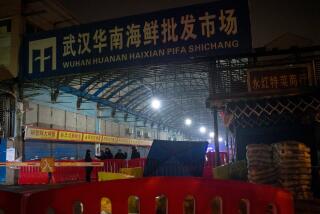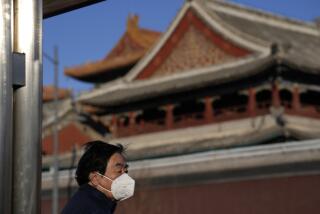China May Reap a Bitter SARS Harvest
- Share via
BEIJING — At a time when farmers throughout China’s vast countryside traditionally reap the year’s first harvest of wheat and begin planting corn, many migrants to urban areas are returning home out of fear, and some are bearing the seeds of a potentially devastating rural epidemic of SARS.
Beijing and other cities that are now the hotbeds of severe acute respiratory syndrome have tried to prevent migrants from fleeing by promising free health care for SARS patients who can’t afford it. But the virus is already in transit to townships and villages, where health-care facilities are woefully inadequate and unprepared to handle a serious outbreak.
“This problem is the product of a dualistic society in which urban and rural populations remain separate and unequal,” said sociologist Lu Xueyi of the Chinese Academy of Social Sciences.
The threat of SARS to migrants, analysts say, highlights the grievous price China is paying for single-mindedly pursuing economic growth in recent years while neglecting improvements in health care, education and the environment. Some observers have dubbed the situation “growth without development.”
Welfare Benefits
China’s 92 million migrant workers are rapidly replacing the employees of urban, state-owned enterprises as the backbone of the nation’s industrial labor force. Yet in contrast to the nation’s 87 million state factory workers, who receive ample welfare benefits, most migrants lack basic medical and unemployment insurance and disability pay.
In the cities, they perform mostly the menial, dirty and dangerous jobs urbanites shun. And while local economies boom, migrants’ salaries have remained largely at the same level for more than a decade, depressed by the overabundance of eager arrivals. In Guangdong province, the world’s manufacturing center, more than half the migrant laborers earn from $50 to $60 a month.
After years of toil, few migrants have increased their education or skill levels. The majority have little hope of joining the nation’s middle class. Denied equal pay and benefits simply by their status as rural residents, “migrants have not put down roots in the cities, and when threatened with SARS, they naturally worry about their homes and return to them,” said Lu.
The concern about rural areas does not mean China’s cities are out of danger.
“Right now, as you know, the biggest problem is in big cities like Beijing and also in Guangdong,” the nominee to become the World Health Organization’s new director general, Jong-wook Lee, said Friday after meeting with Foreign Minister Li Zhaoxing and Health Minister Wu Yi. “Of course it’s spreading to other provinces, but not that big numbers.”
Infection Rate
The infection rate in Taiwan appeared to be accelerating, with 18 new cases reported Friday and 23 more today, along with four fatalities. But Beijing -- leading the world in SARS cases -- reported its lowest daily toll Friday after two weeks of double- and triple-digit increases: 48 new infections and two deaths. Health Ministry statistics showed mainland China with a total of 4,805 confirmed and 2,566 suspected SARS cases. The disease has killed 230 people in China, while 1,582 patients have recovered.
The exodus of laborers from the capital was set in motion late last month by the government’s admission that it had 10 times the number of SARS cases previously reported and that it was firing the city’s mayor and the nation’s health minister.
China’s Cabinet has ordered municipal governments and employers not to fire migrant laborers or send them home. But that made no difference to Yi Changqing and three fellow villagers as they sat on their luggage outside Beijing Train Station this week waiting to return to the eastern province of Shandong.
“Our boss said we weren’t allowed to leave, but he didn’t discuss who would pay our medical fees if we got sick,” Yi explained. “We were afraid of getting SARS, so we all quit.”
Yi and the others came to Beijing two months ago and found work collecting and recycling trash at a small private firm run by a fellow villager.
“There were several hundred people in our company, and we all quit. We didn’t even make back the money we spent coming here,” he said.
Ordinarily, migrants must pay for their own medical care or rely on the charity of their employers. A 1999 Beijing municipal regulation on epidemic prevention among temporary residents stipulates employers should pay their workers’ health-care costs while the unemployed must pay their own.
Among the luckier migrants in Beijing on Friday was a 38-year-old carpenter surnamed Li. He was part of a crew of thousands of workers from three provinces building the Kuntai International Financial Center downtown.
“There’s no problem here. We don’t feel we have anything to fear, so none of us have left,” said Li, a short and wiry man in a hard hat who has spent three years working away from his home province of Sichuan.
Li explained that his company, run by the Beijing government, had guaranteed his medical costs and was observing new government requirements that construction companies house no more than 15 workers to a room.
Although the exact number of migrants infected with SARS is not known, they are not among the hardest-hit professions, such as doctors and nurses. Yet their numbers and mobility have health experts worried.
In recent days, about 800,000 migrants have returned to Henan, including 290,000 from May 1 to 4, state media have reported, although this is a small fraction of the 5 million migrants from the most populous province.
On most days this week, provincial health authorities have issued lists of trains believed to have transported SARS patients from Beijing to the provinces and have asked passengers to report to medical observation stations.
China’s Railroad Ministry reported that as of Thursday, its personnel had dealt with 1,443 cases of SARS on trains and at stations nationwide. Railway staff had turned in 1,225 suspected SARS cases and 7,261 people who had come into contact with them to health authorities for observation or quarantining.
China’s health and finance ministries have promised free medical treatment for all low-income urban and rural SARS patients. The government has allocated about $243 million to cover local governments’ and employers’ expenses in treating SARS patients who lack medical insurance. The bulk of the money will go to inland provinces whose economic growth lags far behind that of coastal provinces.
There is no way to calculate what the cost of treating China’s SARS victims will be, however. According to a survey by Beijing University’s Health Policy and Management Research Center, a serious case of SARS can entail artificial respirators, steroid treatment and other hospitalization costs of up to $390 a day. This amounts to half a year’s pay for many migrants, and treatment can last for weeks.
Municipal governments’ inability to cover such expenses is evident in the conflicting signals they are sending migrant workers. Beijing’s government has ordered interior decoration work to stop and entertainment venues to close. These businesses are largely staffed by migrants, who are left with little choice but to return home.
More to Read
Sign up for Essential California
The most important California stories and recommendations in your inbox every morning.
You may occasionally receive promotional content from the Los Angeles Times.













